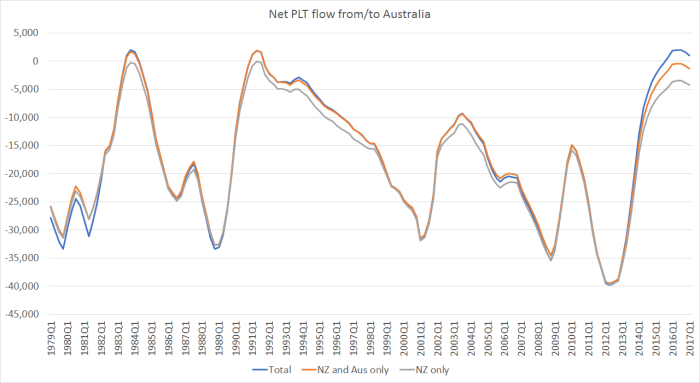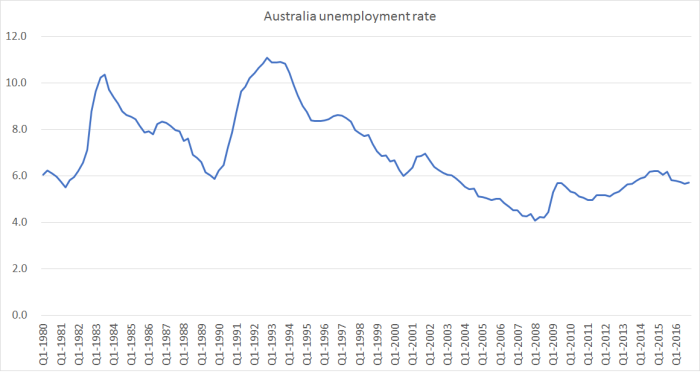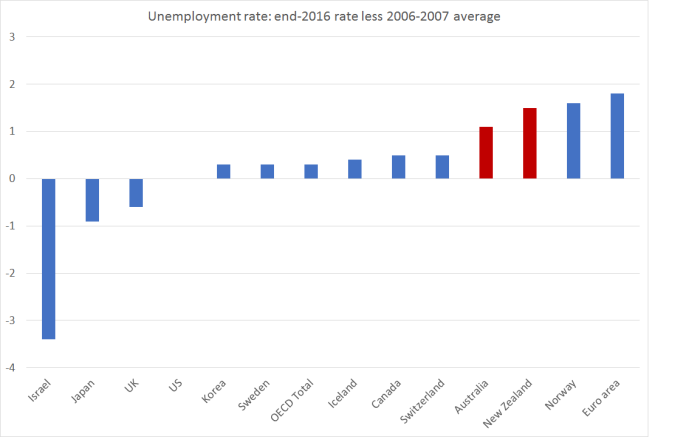I had things more interesting (at least to me) to write about today, but I heard the Minister of Finance on Morning Report talking up the alleged strength of the New Zealand economy, noting that we were now – in some way or another – doing what south-east Queensland had done previously, becoming all that we always wanted to be, and so New Zealanders weren’t fleeing the country any more. He was careful not to suggest that the diaspora is coming home – they simply aren’t, and haven’t at any time in the 40 years since the large trend net outflow began. As if it is somehow relevant to current New Zealand immigration policy debates – and recall that immigration policy is about non-citizens – he and others keep telling us “but they could”. It can happen. It did to some extent in Ireland, but it happened there after they structurally transformed their economy and successfully lifted their productivity performance. There is no sign of such a successful transformation here, whether under this government or the long run of its predecessors.
I’ve run this cartoon before

As I noted, since this was first run in early 1991
…. we’ve had Bill Birch, Winston Peters, Bill English, Michael Cullen, and Bill English again, and although we’ve had plenty of cyclical ups and downs, never at any time have we looked like successfully or sustainably reversing our relative economic decline.
And now we can add Steven Joyce to the list.
But what about those net migration flows to Australia that the Minister was talking about?

Going back 1978/79, I’ve shown three different measures of net outflow here:
- New Zealand citizens only
- New Zealand and Australian citizens (the group not requiring specific approval to move trans-Tasman)
- all citizenships
Mostly the patterns are all but identical, and dominated by fluctuations in the movement of New Zealand citizens. That makes sense: New Zealanders are free to move, and New Zealand has been materially poorer than Australia throughout this almost 40 year period. And over that period, there is no very obvious change in the trend – just large average outflows, but very large cyclical fluctuations in those net outflows.
It is interesting that right at the end of the chart there is some divergence. Over the last year, for the first time in 40 years, there has been a net inflow of around 2000 non New Zealand/non-Australian citizens from Australia. I’m not quite sure why that is, but it is broadly consistent with the theme of this post. Given a choice between going to Australia or staying in New Zealand, not many people tend to go when the Australian labour market is weak. Over the last 12 months, a net 4206 New Zealanders left for Australia, but that is a lot lower than the average of around 25000 in a typical year.
In that chart above there have been five episodes when the net flow to Australia (on any of the measures shrunk a lot for a period). The peaks were around:
- 1982/83
- 1991
- 2002/03
- 2009/10
- the present.
And here is a chart of Australia’s unemployment rate.

It shouldn’t be any great surprise that all those temporary reductions in the net outflow to Australia coincided with periods of increased unemployment in Australia. If anything, the Australian unemployment rate looks more important as an explanatory factor than, say, the difference between the New Zealand and Australian unemployment rates. In 1991, for example, both countries had very high unemployment – and at present both countries have unemployment rates well above pre-recession levels.
The greater importance of the Australian unemployment rate shouldn’t be a surprise. New Zealanders don’t need to have a firm job offer, or advance approval, to move to Australia. They can do so “on spec”, looking for work once they arrive. But a typical person will be much less likely to take that risk if the search process in Australia is going to be long and arduous and might fail altogether. And the risks have increased over the years, as Australian first tightened access to welfare for New Zealanders living in Australia, and then as people become more aware of the rather limited entitlements New Zealanders have there, even if they have been in Australia for some years.
It isn’t a mechanical relationship of course. And the Australian unemployment rate now – at around 6 per cent – is a lot lower than it was in those 1983 and 1991 peaks. But since the wage gaps between New Zealand and Australia haven’t narrowed at all, and the productivity gaps have continued to widen, it seems only prudent to assume that as and when the Australian labour market improves, the net outflow to Australia will resume in something like full historical numbers.
In the repeated burble from the government about the alleged strength of the New Zealand economy, it is often overlooked that while our unemployment rate is not high in absolute terms it is still well above what we experienced pre-recession, and more so than is the case for most other advanced countries that have control of their own monetary policy. And Australia is in much the same position,

And even most of these countries largely ran out of conventional monetary policy room. Neither New Zealand or Australia did. Neither labour market is that strong. Against that backdrop it shouldn’t really be surprising that the outflow to Australia has temporarily slowed. It doesn’t reflect any credit (or discredit for that matter) on our government. It looks like mostly a cyclical issue in Australia. An easier stance of policy by the Reserve Bank of Australia – which would have been warranted with inflation persistently below target – would probably have seen rather stronger outflows even over the last couple of years.
UPDATE: Just to reinforce the point about Australian unemployment, here is an ABS chart from a few months ago highlighting how their underemployment measure has not fallen even as the official unemployment rate has.
Graph 1, Unemployment and Underemployment rate, November 1980 to November 2016
Larger cities with more people is always more attractive with younger people looking for career opportunities and progression. Also a much better social lifestyle. With 50 to 70 level high rise apartment towers, developers in Australia have been able to build at a much cheaper price per unit with economies of scale resulting in cheaper apartments for sale.
LikeLike
Yes they do have the big cities but lots of Kiwis are in smaller places, out mining, tourism and so on. We’ve become the Mexicans of Australia – no offence intended.
LikeLike
That’s not true. Most kiwis have ended up in highly qualified jobs in the larger cities. The top CEOs of those big monopoly Australia banks are mainly kiwis. The senior team they have also are made up of a lot of kiwis.
Indeed there is a large number working in the mining industry due to the big pay packages but these are the kiwis that are returning to NZ in the last couple of years due to the down turn in the Australian mining sector.
LikeLike
I have a written another article on the economic factors which make cities successful. Using Tokyo as an example -like you have previously. These factors might influence the movement of peoples. So perhaps this is indirectly related to your current article Michael.
View at Medium.com
LikeLike
http://www.theaustralian.com.au/news/inquirer/better-cities-myths-surrounding-great-urban-choke/news-story/6a092ebd52ee6f2d3cd6c9f535fabdd7
LikeLike
https://www.brookings.edu/research/reforming-land-use-regulations/
LikeLike
Queensland – are you really sure?
In the years after the 1990’s “recession we had to have” and the State of Victoria chucked out the Kirner Labour government (which had made many serious mistakes) turning it into what became known as the rust-belt state and elected the Jeff Kennett government who razed the state to the ground selling off SOE’s and relocating many State Government Departments to the regions. Unemployment skyrocketed. Many, many Victorians left the state and migrated to Queensland only to find there were no jobs, no industry, no industries. Most of them returned back to Victoria in the following years.
The biggest industry on the Gold Coast was unemployed New Zealanders
Not sure Queensland has redressed the imbalance of paucity of jobs in the state. If you were leaving New Zealand looking for a high paying non-coal-mining job then Queensland would be the last place you would head to
LikeLike
I’m just quoting the Minister. But lots of NZ emigrants do end up in and around Brisbane.
LikeLike
Yeah
I get irritated by the utter piffle that comes out of the mouths of our politicians
Much of it is aided and abetted by the absence or with-holding of meaningful data, as highlighted by you over immigration stats and MBIE
LikeLiked by 1 person
Sometimes you need to fact-check these guys before blasting into print
LikeLike
Property prices drop 40pc in Australian city
Families in Western Australia are at breaking point, plagued with mounting debts they can’t pay off, as they face the reality of a collapsing economy. As properties decrease significantly in value and unemployment rates rise, many are now struggling to find jobs to make ends meet.
I think Steven Joyce was referring to this Western Australian cities feeling the pain of the downturn in mining.
http://www.nzherald.co.nz/business/news/article.cfm?c_id=3&objectid=11846339
LikeLike
Gold Coast is a tourist city. The permanent population is only 500,000. Most of the jobs are parttime and in the hospitality and service sector which have peak seasons. The largest income generators are the restaurants and the theme parks.
Gold Coast does have more highrise apartment towers than Auckland has with 1.5 million people. Lovely place, pity there are no decent jobs.
LikeLike
Glad you brought it up Michael, I touched on the Aussie/Kiwi common labour market a few days ago.
Surprising, given our supposed labour and skills shortages, that more Aussies and Kiwis aren’t flocking across the ditch. Well not really since our wages have been consistently undermined with cheap desperate third world labour. Thank you National.
LikeLiked by 3 people
In fairness to this govt, the GDP/productivity/wages gaps have been overseen by successive govts of both parties since at least the mid 70s.
LikeLike
Well given that the tourism and international student market is a $20 billion industry and they are foreigners. They need to eat foreign food and need foreign speaking waiters, foreign speaking front desk reception, foreign speaking prostitutes. It is rather difficult to train locals to service foreign tourist.
Unfortunately with the RBNZ severely damaging the productive industries we are left with a very substantial tourist industrythat can survive our higher interest rates and higher NZD.
LikeLike
I can’t cut and paste here, but an early April 2017 Essential/YouGov poll of Australians showed that 13% thought their “general standard of living” was getting better and 49% thought it was getting worse. Housing affordability, energy prices and quality of political representation were all seen as getting worse by an overwhelming majority of 4 to 1 or more. Anecdotally, many people in Sydney are citing overcrowding, congestion and traffic as big negatives. Australia used to be famous for its lifestyle, but not any more.
That said, Australia still has far higher paying jobs than NZ so people will still come here for the pay rise if they can get the gig.
LikeLike